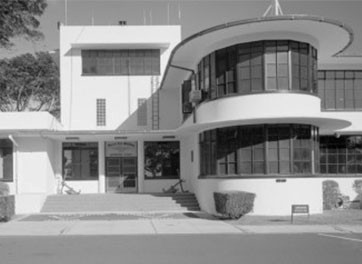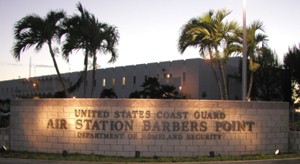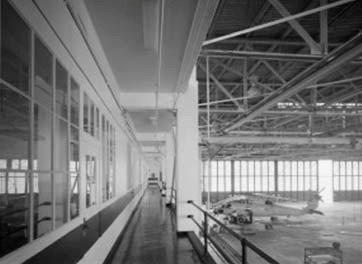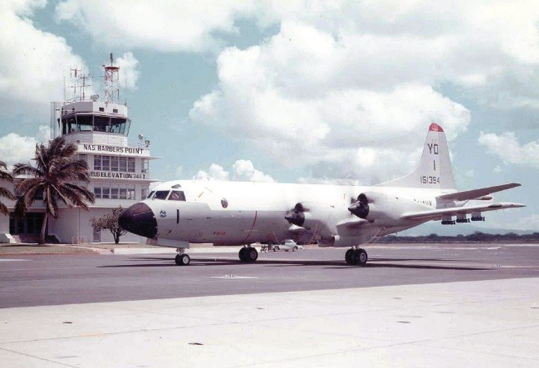NAS Barber Point’s Storied History
By Kristen Pedersen

Naval Air Station Barbers Point Entrance
Who was Barber?
Barbers Point was named for Henry Barber, the captain of the Arthur, a 100-foot British vessel that ran aground at the point during a storm in 1796. According to various sources, Barber was on his way from Honolulu to Kauai to pick up a load of yams when a storm hit Oahu. Barber “determined to get underway despite the storm, hoisted anchor…All other captains held their ships in port while Arthur was deluged by wind, rain and pounding surf.” The ship went down taking with it six crewmembers. The survivors struggled ashore near a tract of land referred to by native Hawaiians as “Kalaeloa” (long cape or headland), a legendary birthplace of Hawaiian kings. Kalaeloa later became known as Barbers Point. Both names are used today.
Naval Air Station (NAS) Barbers Point
NAS Barbers Point began life in the early 1930’s when the Navy leased some land from the James Campbell estate to moor a blimp (dirigible). A few years later, the Navy leased another section of the estate to build an outlying field near the mooring, but it was never used. Not an auspicious start!
In 1940, after the original lease expired, an additional parcel of 3500 acres was acquired by the Navy to enlarge the outlying field and establish the Ewa Marine Corps Air Station. It was completed in 1941. Around this same time, the Navy decided to expand its aviation facility at Barbers Point, but base construction was interrupted by the attack on Oahu on December 7, 1941. The main concentration of the attack occurred at Pearl Harbor, but several other installations were heavily damaged, including the Ewa Marine Corps Air Station and a lot of equipment.
After the attack, there was a huge need for more facilities to train pilots, so construction resumed at Barbers Point. The build-up wasn’t complete when the naval air station began operations in April 1942. The new station immediately became a center of aviation activity as the Navy ramped up to wage war across the Pacific.

AS Administration Building, Library of Congress
The new operation focused on training carrier air squadrons for deployment in the west. At the height of the war, the air station had 6500 active duty military, family members, and civilians. The ‘crossroads of the Pacific’ was the largest naval air station in the Pacific, and Barbers Point was the homeport for many naval and defense organizations, including maritime surveillance and anti-submarine warfare aircraft squadrons, Defense Investigative Service, Defense Reutilization and Marketing Office (DRMO), a Hawaii Air National Guard (297th Air Traffic Control Squadron) air traffic control facility, Fleet Imaging Facility and Commander, Patrol Wings, US Pacific Fleet.

USCG Air Station Barbers Point Entrance, photo USCG
United States Coast Guard Air Station Barbers Point
After the war, NAS Barbers Point remained busy. In 1949, the Coast Guard began operating an air facility on the base and in 1965 became officially designated as Coast Guard Air Station Barbers Point. It was, and is, the only Coast Guard aviation unit in the 14th Coast Guard district. Today, the property is also home to Naval Air Museum Barbers Point which preserves the history of the base and maintains a collection of aircraft that reflect the US Navy, Marines, and Coast Guard’s presence on Barbers Point and in the state of Hawaii.
Historical Timeline of NAS Barbers Point – A Vital Part of Hawai‘i’s Military History:
- 1796 – Henry Barber shipwrecks the Arthur at Kalaeloa
- 1930’s – Navy leases its first 3,000 sq. ft. parcel of land from the Campbell Estate to moor a blimp
- 1940 – Navy buys 3500 acres from the Campbell Estate to build the Ewa Marine Corps Air Station
- 1941 – Japanese attack Oahu and destroy 34 aircraft at the Ewa MCAS
- 1942 – Navy commissions NAS Barbers Point
- 1949 – Ewa Marine Corps Air Station was incorporated into NAS Barbers Point
- 1949 – US Coast Guard air facility becomes operational
- 1965 – Coast Guard air facility is commissioned USCG Air Station Barbers Point
- 1993 – The Base Closure and Realignment Commission decides to close the NAS
- 1997 – Hawaii legislature establishes 2150 acres as the Kalaeloa Community Development District
- 1998 – Federal government transfers 500 acres to the Department of Hawaiian Home Lands
- 1999 – NAS Barbers Point officially closes
Base Closure
If you are a resident or frequent visitor to Oahu, you probably know that there is no longer a Navy or Marine Corps air station at Barbers Point. In 1993, NAS Barbers Point was recommended for closure in by the Base Closure and Realignment Commission. Closing the air station would save the Navy $12 million per year. With many structures over 50 years old, an evaluation of the air station land was necessary to determine any historic properties before it could be repurposed.
The closure announcement triggered the state of Hawaii to establish the Barbers Point NAS Redevelopment Commission, which was responsible for guiding the reuse of the property.
Section 106 is a process designated by the National Historic Preservation Act that requires federal agencies to identify historic properties and determine the potential effects of any projects that could impact those properties.
The following is an excerpt from the Advisory Council on Historic Preservation’s report on the Barbers Point early Section 106 results:
The Navy completed consultation with the Hawaii State Historic Preservation Officer (SHPO) and other consulting parties in 1998 and in 2010 regarding the base closure and land transfer. The Navy concluded the Section 106 process in both instances with a finding of “no historic properties adversely affected” provided certain conditions were met, including placing historic preservation covenants on particular transferred properties to ensure future preservation and appropriate treatment. Restrictive covenants place land use controls on each property and require consultation with the SHPO for activities that would potentially impact cultural resources.
The station was closed in 1999, and in 2002, redevelopment responsibility was transferred from the Redevelopment Commission to the Hawaii Community Development Authority (HCDA). The Navy retained 1,055 acres for military housing and support facilities and conveyed 334 acres to HCDA and another 819 acres to other state agencies. The HCDA partnered with a nonprofit organization, the Kalaeloa Heritage and Legacy Foundation, to build the Kalaeloa Heritage Park on a portion of the state lands. The park provides public access and interpretation of cultural elements on the site and the broader area.
When the Navy’s last naval air station in the Hawaiian Islands ended 57 years of service, the Section 106 and base closure processes resulted in the preservation of Native Hawaiian archaeological sites and access to previously restricted cultural sites for Native Hawaiians and the public through development of the Kalaeloa Heritage Park. The Section 106 process and the work of the Kapolei Hawaiian Civic Club led to the identification of the Hawaiian cultural presence in the former Navy property. Federal, state, and private agencies partnered with local community groups to create the 77-acre park containing more than 177 relatively undisturbed archaeological features including a heiau (temple) and habitation and agricultural sites. Now the cultural sites at Kalaeloa Heritage Park are being preserved to educate the community on centuries-old Hawaiian cultural traditions and practices, advocate cultural awareness, and maintain an authentic Hawaiian presence in the Kalaeloa area.
Ongoing Efforts
The Navy has updated its assessment of historic properties in the Barbers Point area, including an evaluation of buildings that were constructed during World War II and the Cold War historic periods. The assessments recognize that some properties may have attained historic significance in the 18 years since the base closed, especially for the Cold War period.
HHF selected the Naval Air Station Barbers Point Historic Properties Assessment Project to receive a 2017 Preservation Commendation. The report identified sites and buildings that are historically significant so they may be included in planning efforts. The project included historical research and updates to the inventory documentation of 51 historic facilities and structures.
Additionally, the Ewa Mooring Mast Battlefield at the former MCAS ‘Ewa Air Station, was listed on the National Register of Historic Places in 2016 for its association with the December 7, 1941 battle.
HHF continues as a consulting party to the Navy to review covenants and other long-term protections for historic resources as lands are transferred out of federal ownership and works with the property owners on plans for rehabilitation and reuse.
Not only has part of the Barbers Point Navy property been turned into the 77-acre Kalaeloa park with significant archeological sites, but one of the aircraft maintenance facility buildings has recently been transformed into a film and television studio. The huge hangar-like structure was leased by the Navy to the Hawaii State Film Office to be used as production space for major film and television projects, like ABC Studios and Marvel Television’s Inhumans.

NAS Maintenance Hanger, Library of Congress

Kristen Pedersen is an adjunct professor in Strategic Communication and Organizational Behavior at Portland State University and Managing Director at Mambo Media. Prior to finishing her PhD, she worked in film and television in Miami, Los Angeles, and Brussels, Belgium. She is a U.S. Coast Guard veteran, an avid researcher, and has many fond childhood memories of Kailua Beach.
Source material:
Former Naval Air Station Barbers Point. (1999). Retrieved from https://www.bracpmo.navy.mil/brac_bases/other_west/former_nas_barbers_point.html
Henry Barber. (1939, July 2). Honolulu Advertiser, 2 July 1939. Retrieved from http://the.honoluluadvertiser.com/article/2004/Aug/29/il/il10a.html
Kakesoko, G.K. (1999, July 1). Goodbye Barbers Point, Hello Kalaeloa. Star Bulletin. Retrieved from http://archives.starbulletin.com/1999/07/01/news/story2.html
Shimogawa, D. (2017, Feb 8). Disney, Marvel head to Hawaii to film ‘Marvel: The Inhumans’ IMAX movie and TV series. The Business Journals. Retrieved from http://www.bizjournals.com/pacific/news/2017/02/08/disney-marvel-head-to-hawaii-to-film-marvel-the.html
Former Navy Base Preserves Native Hawaiian Heritage. (n.d.). Retrieved from
http://www.achp.gov/KalaeloaPark.pdf


